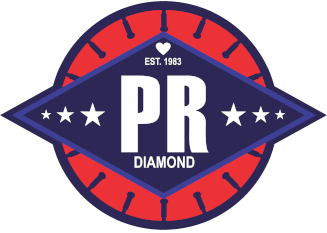FAQ
Any product that is returned to PR Diamond must have a valid Return Merchandise Authorization number (RMA). Please contact PR Diamond to obtain this number before sending any products back. To obtain a return number, please follow these steps:
- Contact your sales representative at 800-445-1697 to receive a Returned Merchandise Authorization number (RMA).
- Products returned to PR Diamond without an RMA number will not be accepted and returned to sender.
- All items being returned must be returned prepaid.
- All items being returned must have been purchased within the previous 12 months (1 year).
- Up to 30% restocking fee may be applied. Freight charges are non-refundable.
LIMITED ONE YEAR WARRANTY
PR Diamond Products, Inc warrants all of its diamond tools against possible defects in material and workmanship for one (1) year from date of purchase. All laser welded blades and bits are warranted against warping, wobbling, or segment loss due to weld failure. Determination of the applicability of warranty will be made after our Warranty Claims Department inspects the product.
This warranty will not apply to any tool which has been subject to misuse or improper service, that has been damaged in transit or handling, or that have been altered or repaired by an unauthorized representative. This warranty does not cover defects caused by or resulting from misuse, abuse, neglect or damage caused by accident or the failure to provide reasonable maintenance. This warranty is void if the product is used in a manner
not recommended by the manufacturer.
Any diamond tool covered under the warranty will be repaired or replaced at PR Diamond Products’ option free of charge. Any claim arising under this warranty must be submitted by the original purchaser within the warranty period specified above and a proof of purchase must accompany all returns. PR Diamond Products shall not be responsible for or obligated to pay for freight or other transportation related costs or expenses in connection with any defective, misused, or abused products or components that are either returned to PR Diamond’s facility and/or any replacement products that are shipped from PR Diamond pursuant to this warranty.
Parts and labor needed to maintain products and the replacement or repair of products due to normal wear and tear are the purchaser’s responsibility and are not covered by this warranty. All products replaced by this warranty become the property of PR Diamond Products, Inc. All repairs or replacements will be considered to be part of the original product and any warranty on such parts will expire coincidentally with the original warranty.
In no event shall any liability under this warranty exceed the replacement cost of any defective product or component thereof. Any product damaged, due to careless or improper use, is not covered under any warranty
Most PR Diamond brand products are either made or assembled in America. We do carry products from vendors who are not American companies.
Diamond blades do not really “cut” like a knife… they grind. During the manufacturing process, individual diamond crystals are exposed on the outside edge and sides of the diamond segments or rim. These exposed surface diamonds do the grinding work. The metal “matrix” locks each diamond in place. Trailing behind each exposed diamond is a “bond tail” which helps support the diamond.
While the blade rotates on the arbor shaft of the saw, the operator pushes the blade into the material. The blade begins to cut through the material, while the material begins wearing away the blade. Exposed, surface diamonds score the material, grinding it into a fine powder. Embedded diamonds remain beneath the surface. Exposed diamonds crack or fracture as they cut, breaking down into even smaller pieces. Hard, dense materials cause the diamonds to fracture even faster.
The material also begins to wear away the metal matrix through abrasion. Highly abrasive materials will cause the matrix to wear faster, allowing new layers of diamond exposure to continue cutting. This continuous grinding and wearing process continues until the blade is “worn out.” Sometimes a small, unusable part of the segments or rim may remain. It is important to understand that the diamond blade and the material must work together (or interact) for the blade to cut effectively. In order for a diamond blade to work properly, the diamond type, quality and grit size must be suited for the saw and the material. The metal matrix must also be matched to the material to be cut.
Blades for cutting hard, dense (less abrasive) materials (such as tile, hard brick, stone or hard-cured concrete) require a softer metal matrix. The softer metal matrix. Wears faster, replacing worn-out diamonds fast enough for the blade to keep cutting. Blades for soft, abrasive materials (such as block, green concrete or asphalt) must have a hard metal matrix to resist abrasion and hold the diamonds longer.
The segment or rim is slightly wider than the blade core. This side clearance allows the cutting edge to penetrate through the material without steel drag. To attach the diamond rim or segments securely to the steel core, several different processes are used.
- Brazing Silver solder is placed between the segment or rim and the core. At high temperatures, the solder melts and bonds the two parts together.
- Laser Welding The diamond segment and steel blade core are welded (fused) together by a laser beam.
- Mechanical Bond A notched, serrated or textured blade core may be used to “lock” the diamond rim or segments onto the edge of the blade.
- Mechanical bonds usually include brazing or other metallurgical bonding processes to hold the rim or segments in place.
- Diffusion Bond Mechanical bond process guaranteed for normal useful life of the blade.

